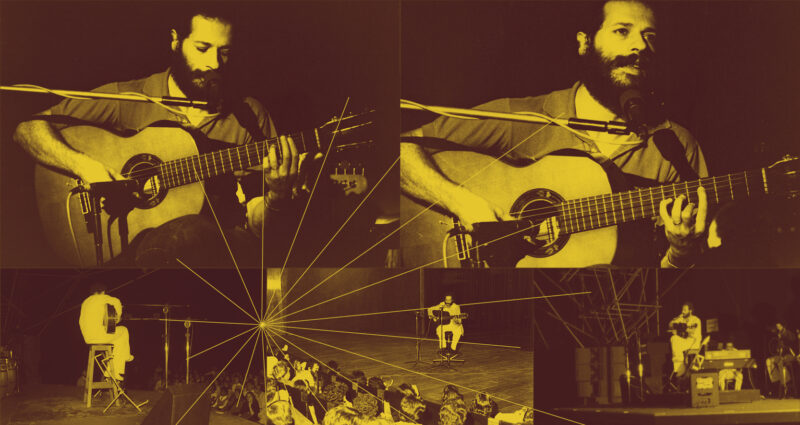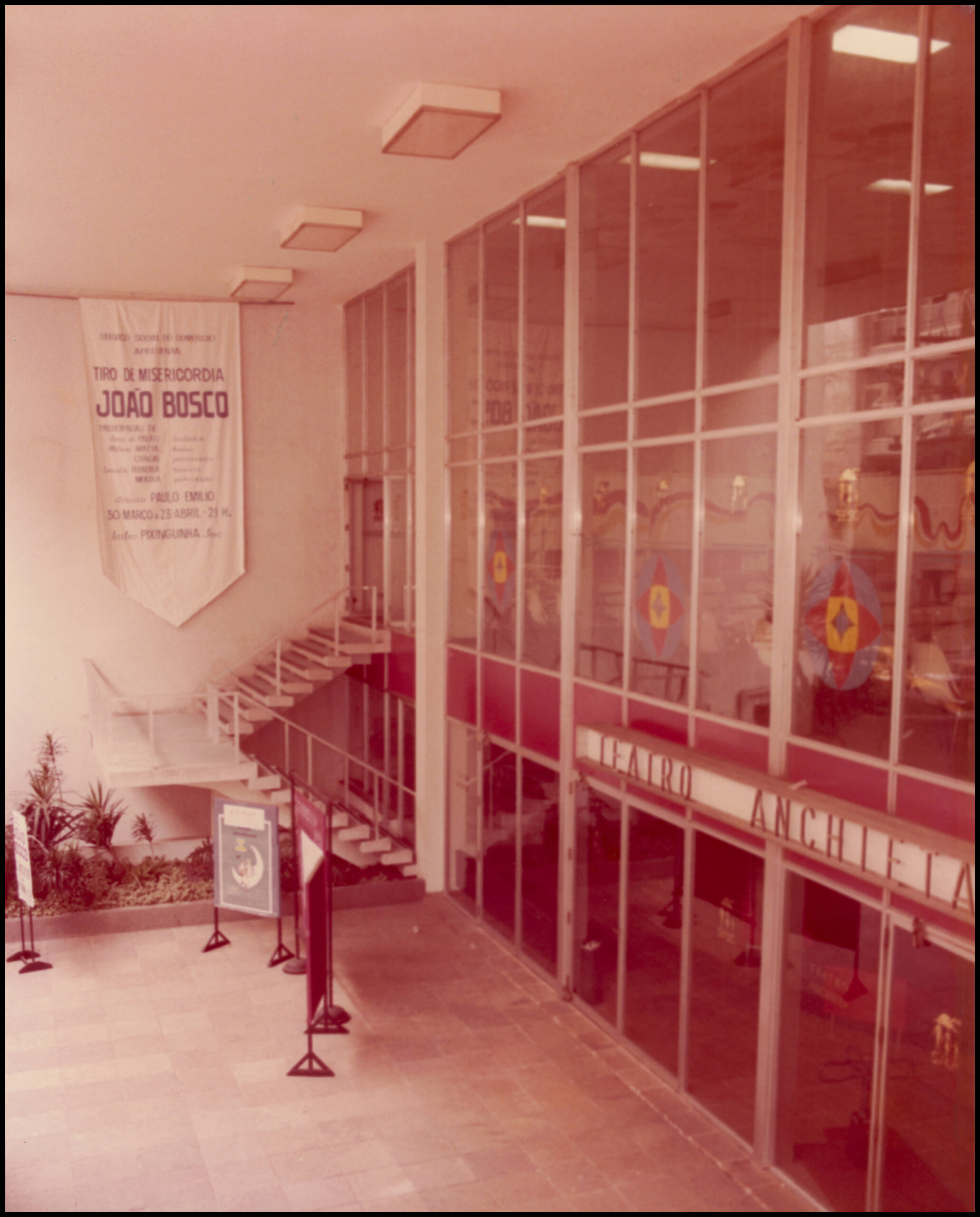
João Bosco was 31 years old and had been in the music industry for nine years when he premiered the tour for his album Tiro de Misericórdia on March 30, 1978, at Teatro Pixinguinha, located at Sesc Consolação in São Paulo. It was his fourth album, and despite the widely proclaimed political opening that the country was beginning to experience, the work had faced censorship: one track had been entirely banned, and another had its lyrics modified, forcing the record label to redo the booklet and delay the release. The album was finally released in December 1977, missing one song (“Essa é a Sua Vida“).
This, however, didn’t prevent the sharp social criticism present in the songs of the duo João Bosco and Aldir Blanc (1946-2020) from shining through in the show that ran at the venue. It lasted for 12 nights, from Thursday to Sunday, until April 23, when the performance that led to the album João Bosco (Ao Vivo no Sesc 1978) was recorded. This album is the third release of the Relicário project by Selo Sesc, which comes to light 45 years after that season.
For the artist, listening to the recording after such a long time allowed him to reconnect with a version of himself that had been hidden away in some corner of memory. “It was very emotional”, he says. “I was listening to a João Bosco that I no longer remembered. Along with that came the ideas of that time. And in a certain way, it made me very happy, because this João Bosco confirms the one of today, the one from Mano Que Zuera (2017), the one from Abricó-de-Macaco (2021). This João Bosco continues to take steps forward in the same direction”, he celebrates.
The show was a retrospective of the singer and composer’s career, featuring songs from his four albums, as well as “Agnus Sei“, his first released song, from the compact album Disco de Bolso do Pasquim: O Tom de Tom Jobim e o Tal de João Bosco (1972) — which on Side A had the then-unreleased “Águas de março” by Jobim. Five songs were from Tiro de Misericórdia six from Caça à Raposa (1975), four from Galos de Briga (1976), and one from João Bosco (1973). The repertoire was filled with classics like “Gênesis (Parto)“, “Latin Lover“, “Kid Cavaquinho“, “Bijuterias“, “De Frente Pro Crime“, “Incompatibilidade de Gênios“, and “Dois Pra Lá, Dois Pra Cá“, which had projected João and Aldir when recorded by Elis Regina in the album Elis in 1974.
If the recently released album was the saga of a Brazilian hero that began with his birth in “Gênesis (Parto)” and ended with his death in the title track, the show was no different: the repertoire was divided into four thematic sections, with songs that exposed social injustices and political woes of Brazil, but also those that lyrically and humorously depicted the joys and misfortunes of various characters from the suburbs of Rio de Janeiro.
“The first part is childhood, the lyrical vision found in various compositions; the contact with life, the understanding of the world, of women, as in ‘Dois Pra Lá, Dois Pra Cá‘. The third section opens the second part of the program and presents the daily news and life, characteristics of songs like ‘De Frente Pro Crime‘. And the last section is the synthesis of everything, the entire work of the two, highlighting the political weight,” explained Paulo Emílio (1941-1990), the director of the show, to Estado de S. Paulo at the time.
The poet and composer, who also handled lighting, had been part of the University Artistic Movement (MAU) alongside Aldir Blanc, Gonzaguinha (1945-1991), and Ivan Lins, among others. Since the time João released “Agnus Sei“, his first song, Aldir had taken on the role of introducing him during tours, as he was the lyricist for most of the songs recorded by him up to that point. However, Aldir had stopped flying by plane, so João invited Paulo Emílio to direct him. “He was very close to Aldir and knew how he would want everything to be. So, it was a perfect fit, because it was a way for Aldir to also be present,” João recalls.



The opening, with “Gênesis (Parto)“, featuring almost seven minutes of percussion (played by four musicians: two percussionists, the drummer, and the bassist), punctuated only by vocal improvisations, already gave a hint of what was to come: a show marked by the African influence in the formation of Brazilian music, a theme that would run through his entire body of work. João mentions that his connection to this sound comes from his hometown, Ponte Nova (MG), where he enjoyed following the congada blocs, an Afro-Brazilian cultural and religious expression that blends dance, music, theater, and spirituality from African diaspora and Catholic origins. “The birth is Africa. That’s where we were born, that’s where we come from,” the artist says.
João Bosco explains that the choice of the repertoire was permeated by percussive force and baroque musicality, another of his major influences. From Minas Gerais, where he was born and raised, to Rio de Janeiro, where he started his career and found his partner with whom he composed for decades, creating more than a hundred songs, emerged the sound that flows into his music. “These moments that take us to the universe of a local Africa, which is samba, jongo, Afro-samba, and the like. Because these things have different names, but they belong to the same universe,” he analyzes. Bolero, choro, jazz, and even a marcha-rancho (“Rancho da Goiabada“) join this range of rhythms, often intertwining.
João Bosco, on vocals and guitar, is accompanied in the show by Darcy de Paulo (1953-1000) on Fender Rhodes, harp strings, and arrangements; Nilson Matta on bass; Everaldo Ferreira on drums; and Chacal (1941-2011) and Moura on percussion. The recording reconnected João with the memory of these artists, since Matta is the only one still alive — Paulo Emílio and Aldir Blanc have also passed away. “In a certain way, listening to this show also brought back these people to me, who are very dear to me. And seeing them performing with me was really beautiful. This issue of memory shows us how important it is to document it”, he observes.
In the show, which took place on Sunday, April 23, he addresses the audience twice. The first is after the bolero “Latin Lover,” where he expresses gratitude. “Today is our last day here. In this theater, in this Sesc program. And on this last day, we are very happy to have done this work here. Especially for the employees, who are an audience we make sure hear our things. And also to thank the people who helped us here, in this work, from our dresser to that light up there. A tribute to the Abajur Lilás, of Quem-Quem”, the last phrase a reference to the bolero “Que será” by Marino Pinto and Mário Rossi, a success sung by Dalva de Oliveira in 1950 (from the lyrics: “Que será / Da luz difusa do abajur lilás / Se nunca mais vier a iluminar / Outras noites iguais” / What will become / Of the diffused light of the lilac lamp / If it will never again illuminate / Other similar nights).
Quem-Quem, in turn, was the sound technician for Roberto Carlos. João doesn’t remember exactly what happened, but he believes that Quem-Quem might have handled the sound that night out of friendship or was close to the sound when he spoke. “Quem-Quem worked with me on the Souza Cruz project, ‘Sabor Bem Brasil,’ which featured Luiz Gonzaga, Clara Nunes, Altamiro Carrilho, Waldir Azevedo, me, and Caçulinha Regional. He was the sound engineer. This was from ’75 to ’76. He was very good friends with Caçulinha. And he became very, very good friends with me. He was a really cool person, a damn good sound engineer,” he praises. The second time João communicates with the audience is at the beginning of “Kid Cavaquinho“, when he invites the audience to sing along: “Now you guys!” and they promptly comply.
Between songs, he sometimes recites texts, some of which were specially created for the Tiro de Misericórdia tour. “In September, if Venus helps me, someone will come. I’m a Virgo, and just thinking about it makes me dizzy”, he says, leading into “Bijuterias“. In the middle of “Agnus Sei“, amid verses and vocal improvisations, he says, “Where were they born, lived, and will live, the courtesans? The depressed, humiliated and offended, maidens, matrons, bookies, corsairs, work brigades, and riots?”. More improvisations, and he continues, “Where did they walk and step, and throw dice, the pickpockets, pirates, gigolos, pederasts, dentists, toothless, trinkets, amethysts, pivots, cuíca roars, my aunt, my brother, my grandfather? Tenants, unknowns, neighbors, landlords?” And he continues reciting the text as the instruments play in the background.
At the time, he had asked Paulo Emílio to write lines for him, as he needed to say a few things. “This long text in ‘Agnus Sei’ is from him and Aldir. I had forgotten about this thing. It was made specifically for that show, and only for that show,” he emphasizes. Although rap was still an emerging movement in the streets of the Bronx, New York, and largely unknown at that time, João Bosco recalls that the origin of rhythmic singing was in the African continent, which meant that similar expressions had already occurred in Brazil, like the song “Deixa Isso Pra lá” by Jair Rodrigues in 1964. “It’s no coincidence that this show begins with this Africa that is indeed the mother of all, the origin of everything.”
A historic venue, Teatro Pixinguinha was built in three months at Ginásio Vermelho, on the second floor of Sesc Consolação. It was inaugurated in September 1977, had 1,800 seats, and emerged to host the Pixinguinha Project, conceived by Hermínio Bello de Carvalho, the first high-visibility action by Funarte (National Arts Foundation) at the national level. Inspired by the “Seis e Meia” project, which took place at Teatro João Caetano in Rio de Janeiro, its proposal was the circulation of Brazilian music shows performed by duos: generally, a renowned artist and another at the beginning of their career, or someone not well-known to the general public.
João Bosco and Clementina de Jesus, Beth Carvalho and Nelson Cavaquinho, Jards Macalé and Moreira da Silva, Nana Caymmi and Ivan Lins, and Alceu Valença and Jackson do Pandeiro were some of the initial pairings. Soon, the venue started to host individual tours by artists as well, like João Bosco with Tiro de Misericórdia in 1978. Caetano Veloso, Gilberto Gil, Ney Matogrosso, Alceu Valença, Zé Ramalho, A Cor do Som, Ivan Lins, Luiz Melodia, Belchior, Hermeto Pascoal, Jackson do Pandeiro, Fafá de Belém, Raul Seixas, Célia, Sérgio Ricardo, and Elomar and Arthur Moreira Lima, who recorded the album Parcelada Malunga (1980) together there, were other names that performed at the theater. It closed its doors in 1984.
Kamille Viola is a journalist and music researcher. She wrote the book “África Brasil: um dia Jorge Ben voou para toda a gente ver”, by Edições Sesc.
About Relicário: João Bosco (Ao vivo no Sesc 1978), you may also read:
Utilizamos cookies essenciais para personalizar e aprimorar sua experiência neste site. Ao continuar navegando você concorda com estas condições, detalhadas na nossa Política de Cookies de acordo com a nossa Política de Privacidade.